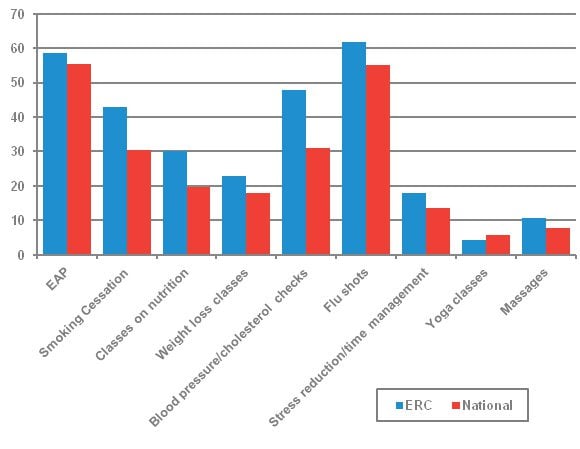Based on the results of the 2013-2014 ERC Policies & Benefits survey, Northeast Ohio employers are well positioned to take advantage of the recently released Affordable Care Act (ACA) regulations increasing the maximum rewards employers may offer employees for participation in wellness programs. Local employers have consistently outpaced the national averages in terms of their wellness initiatives, with specific programs illustrated in Figure 1 below.
One key program that is particularly relevant to Northeast Ohio employers within the context of the ACA regulations is smoking cessation classes. More and more local organizations are placing restrictions on tobacco use as part of their hiring policy and 31.1% of local employers do not allow smoking anywhere on the premises of their organization. In comparison, the national average is 10% lower at 23.1%.
Given these figures it is perhaps unsurprising that 43% of the local sample is already offer smoking cessation classes to their employees, nearly 13% higher than the national sample. As of January 2014, the ACA will allow these employers to offer tobacco-free employees (and those achieving tobacco-free status through cessation programs) up to 50 percent of the premium cost as a reward.
Other areas of wellness in which the region appears to be excelling, include offering blood pressure/cholesterol checks, classes on nutrition, flu shots and weight loss classes- each of these programs are offered by at least 5% more organizations locally than nationally.
Figure 1 │ Percent of employers paying for or contributing to specific programs to encourage employee wellness (Source: 2013-2014 Policies & Benefits Survey)
Employers should also note that after months of speculation about the content of these final rules, the newest ACA regulations do require some of these wellness programs, those that are “health-contingent” to meet specific requirements. Unlike “participatory wellness programs”, these outcomes focused programs can be attached to a reward of up to 30% of the premium cost and are therefore subject to a higher degree of scrutiny. Most notable among these requirements is the “reasonable alternative” standard, which requires employers to offer employees an alternative method of achieving the rewards regardless of health status. According to the final rules issued at the end of May, this reasonable alternative requirement, “is intended to ensure that outcome-based programs are more than mere rewards in return for results…and are instead part of a larger wellness program designed to promote health and prevent disease.”
Additional Resources:
Employee Wellness Programs
ERC’s Preferred Partner, University Hospitals, provides ERC members with a 10% discount on wellness program services including onsite health screenings, health risk assessments, strategic wellness consulting, flu/pneumonia vaccinations, health fairs, and health seminars.
